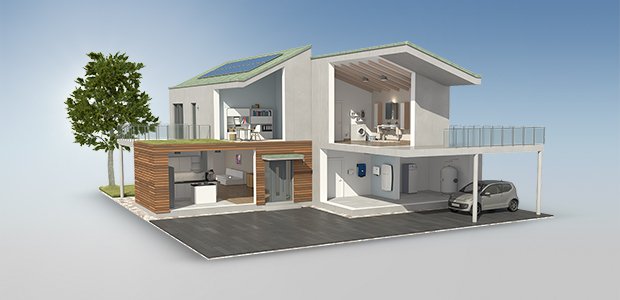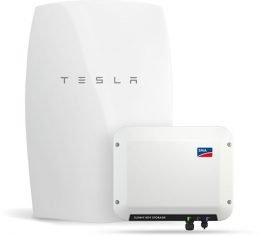Questions and Answers on Solar Power Storage Systems

[Updated August, 25, 2021] “High-voltage, DC coupled, lithium iron phosphate” – the new business field of battery storage for PV systems has brought with it many new technical terms. pv magazine, together with SMA, has held two webinars with the SMA storage system experts Martin Rothert and Michael Ebel and has presented the questions and answers in pv magazine.
We’ve put together a selection of the topics for you here.
Is it possible to connect several storage systems with the Sunny Boy Storage? What genreally determins whether storage systems can be connected into parallel?
The ability to connect up to three Sunny Boy Storage in parallel on a single line conductor or across three line conductors is planned and will be made available for all our customers as a free firmware update. Ultimately, the ability to connect AC coupled storage systems in parallel is simply a question of higher-level PV system managment and the applicable connection standards. By contrast, connecting DC coupled storage systems in prallel is significantly more complex.
[Updated August, 25, 2021] Unfortunately, we can’t say when the ability to connect up to three Sunny Boy Storage in parallel on a single line conductor or across three line conductors will be available.
What kind of personal protection is needed for high-voltage systems?
The battery must have protection class II (double insulation). Thanks to the all-pole sensitive residual-current monitoring unit already integrated in the inverter, no other special protective devices (e.g., type B residual-current devices) are required in the installation.
The question is always asked whether storage systems should be connected using a single-phase or a three-phase system. Are there disadvantages to the three-phase connection?
Firstly, the three-phase inverter has manufacturing costs that are approximately 20% higher, which is usually also reflected in a 20% higher selling price. Secondly, efficiency is poorer when photovoltaic voltage and battery voltage are the same, as the DC link voltage is higher on three-phase inverters. Thirdly, the system’s no-load consumption is higher, as more semiconductors have to be controlled and connected.
In addition, you have to bear in mind that a three-phase inverter capable of handling unbalanced loads is required for grid backup with single-phase loads, something that in many three-phase photovoltaic or hybrid inverters has only extremely limited functionality, or once again results in significantly higher costs. For grid backup, with three-phase inverters you can use only a third of the nominal power per line conductor, which is usually insufficient for many larger or medium loads with a high inrush current. An inverter with 5 kilowatts of power then only has 5 kilowatts divided by 3, equaling 1.66 kilowatts per line conductor.
Battery temperature is crucial to the service life of a battery. Is it better to install an outdoor system in the carport to help keep its temperature low?
In Germany, most domestic storage systems are currently installed indoors. An installation in the basement will enjoy stable temperature conditions over the course of a year, which has a positive effect on the service life of the battery.
Installing a domestic storage system outdoors is only possible if the manufacturer has also approved this, as Tesla has done, for example. To keep the average temperature of an outdoor installation low, the battery should not be exposed to any direct solar irradiation. However, in winter the temperature should also not fall below 0°C too often, as otherwise the battery will need to be heated. Simply put, for the service life the decisive factor is the average annual temperature at the installation site. If the temperature in a shady, protected outdoor area is lower than that in the attic for example, an outdoor installation could be beneficial.
Why was the charge/discharge power on the Sunny Boy Storage set to 2.5 kilowatts and not to 3.3 kilowatts as on the Tesla battery?

Sunny Boy Storage and Tesla Powerwall
The battery inverter power should only be 30% to 50% of the photovoltaic inverter power. This is enough to temporarily store 99% of the excess PV current in the battery, even with a feed-in limitation of 50%. Because typical photovoltaic system values in Europe are usually between 5 and 10 kilowatt-peak, and most typically around 6 t0 8 kilowatt-peak, 2.5 kilowatt-peak battery inverters are ideal for more than 90% of domestic storage systems. On the other hand, the inverter must, above all, also be able to adapt to the typical consumption behavior of the household. Here, approximately 80% of the household consumption is between 3,000 and 7,000 kilowatt hours. This means that the average power consumption is between 350 and 800 watts. During the evening and overnight, when most of the battery discharging takes place, this is significantly lower, meaning that the inverter must be highly efficient, especially in the power output range from 250 to 750 watts. A battery inverter that is too large will, thanks to the higher no-load consumption always associated with this, also always be less efficient at very low power. Here, the Sunny Boy Storage 2.5 plays to its strengths with efficiency of approximately 95%, even at 250 watts.
My wholesaler has said that currently multiple Sunny Boy Smart Energy inverters can not be installed in parallel. This is apparently due to the Sunny Home Manager. Is that right?
No more than one Sunny Boy Smart Energy inverter can be connected in parallel.
Will the Sunny Boy Storage also come with an emergency power function?
[Updated, August, 25, 2021] This function was originally planned. However, it was not implemented because the inverter power of 2.5 kW without any overload turned out to be insufficient for supplying many loads. So it would have been very expensive in terms of price compared to the integrated emergency power function of the battery inverter Sunny Boy Storage 3.7.
How does the use of a heat pump in a single-family home affect optimum battery performance?
A heat pump increases electricity demand over the course of a year, and therefore the ideal inverter power and battery capacity also increases. For the Sunny Boy Storage, in the future this can be very easily factored in by installing two or up to three devices with two or three batteries on two or three different line conductors.
If I want to use photovoltaics and battery-storage systems mainly for directly charging electric vehicles, what is the best solution and design for this? Does it then always make sense to install AC systems?
Yes, because the charging devices in electric vehicles all charge from the AC utility grid and the wall boxes also always have only an AC connection. In theory of course, it would also be possible to charge the car battery directly using DC/DC power controllers, which would also be somewhat more efficient. However, the problem is the fact that neither the PV nor the battery voltages, or indeed the communication between the charging device and the car battery is standardized. The AC charger in the car can’t be dispensed with either, because then the possibility of charging the car via a normal outlet at some point in the future is no longer an option This means that an AC coupling is currently the only sensible option here too.
How high are the recycling costs, if batteries are discarded at a later date?
The take-back of batteries is already regulated by the legislation on batteries. The manufacturer must take back the batteries free of charge. Here, it should be ensured that the battery manufacturer has joined a common take-back system and has already paid the appropriate fees for this when the products were placed on the market. This is the only way to ensure that even if the battery manufacturer becomes insolvent, returning the batteries is still possible, free of charge.
Do you have any further questions?
If so, please enter them in the Comments section.




I have a Sunnyboy 3.6KW inverter and have done some tests and found the the inverter is emitting spurious carrier in the 144 Mhz band. I am a Radio Ham a have noticed these emissions just recently. Invert is about 3 years old. Is this normal for the inverter to emit them. Are these emissions checked during production or is it something which can happen with time – defect with Inverter. Emissions are happening during peak and low production time. When Inverter is switched off emissions dissappear.
Regards
Philip
Hello Philipp,
Please get back to our SMA Service for further support.
We need more technical information in order to support you here (serial number etc.).
Sunny regards
Christiane
Hello SMA team,
my question is why sometimes the battery is charged with the power from the grid, this often happens at the times 2am, 7am, 5pm, ….
What is the reason for this charging?
Thanks in advance
Hello Matthias,
about how much power are we talking here? Is it some Watt or a complete charging of the batteries? A very small amount of energy from the grid to the batteries is normal and no reason for concern.
Sunny regards!
Using the SBS-ABU-200-US-10, how fast will the automatic transfer be in the event of a power outage?
Is this fast enough to work as a UPS? Is there any technical paper you can share?
Hello Mauricio,
Please contact our SMA Service via our SMA Online Service Center for further support.
We need more technical information to assist here.
Sunny regards
Christiane
My installer insisted to link my SunnyBoy.5 to my main power supply. I would prefer the SunnyBoy to charge my batteried first before any power goes into my daily use or into the grid. At this time it’s not sure if I am indeed selling power to the grid. My problem is as the Sunnyboy is connected to the grid when the grid goes down the Sunnyboy’s output goes no where so if it is a longies outage I will run out of power as soon as the batteries run down. Is it possible to turn this around?
Hello Hermann,
In principle, a Sunny Boy should feed in when the SMA system is running in backup mode.
Please contact the Sunny Island-Team within the SMA Service , delivering further details while contacting the SMA Service, thanks.
Sunny regards
Christiane
My question is …
with an 8 KW inverter where the nominal DC Voltage is marked as 580 volts can we exceed that voltage to 900 volts
Hello Udaya,
Please take care that you never reach the maximum voltage that is pointed out for the device.
The MPP (Maximum Power Point) range and spot are not adjustable.
Sunny regards
Christiane
hello
1. Please can the sunny boy storage inverter 6.0kw be connected to form 3phase unit
2. Also what is the size that the battery storage can be expanded to when using the sunny storage 6kw
Hi Eric,
Sorry for the long delay in getting back to you – hope, we can help you still with the following answers:
1.The SBS 6.0 can only be operated as a single-phase system, not as a three-phase system like the Sunny Island. In case you need further assistance on that topic, please contact your local installer or our SMA Service Team.
2. You will find more on that in this technical information (please note that in case of a revision this link will not work anymore). Again, please contact either your installer or the SMA Experts for further support if necessary.
Sunny regards
Christiane
Hello SMA Team, we recently setup a 3 sunny island 8.0H as a three phase, with 3 sunnyboys and also connected to the Grid, everything is working well except when the Grid fails, our battery power is back feeding the grid and we need the right switch which can automatically isolate the Grid when it fails.
Hi I have a sunny island 5048 inverter with 8 x 6 volt ( 3×2 volt per box )1080 ah per battery these were replaced 12mths ago the old system had 12 x 4 volt x1660 ah not shore what the setting were the installer set the new batteries at1080 ah i had a new services person out today I was told that you set the inverter and regulater ah at 8640 ah ( 1080 x8 ) is this correct It has been playing for awhile thank you Dennis Arnett
Hi, Can sunny boy storage sbs 5.0-10 used without battery or battery less operation.
Hi Abdul,
Thanks for your request.
That’s not possible. During commissioning a battery is necessary, otherwise it will not work.
Kind regards,
Anke
Hi I have a sunny island 5048 inverter with 8 x 6 volt ( 3×2 volt per box )1080 ah per battery these were replaced 12mths ago the old system had 12 x 4 volt x1660 ah not shore what the setting were the installer set the new batteries at1080 ah i had a new services person out today I was told that you set the inverter and regulater ah at 8640 ah ( 1080 x8 ) is this correct It has been playing for awhile thank you Dennis Annett
1)Is it possible to connect a sunny island with the pv solar panels directly without the sunny boy so as to charge a battery bank.
2) Is it possible to power a 2 kw solar water heater back-up element using excess pv capacity after the battery bank is fully charged with the sunny island?
3)For the off grid sunny island, Is there a provision which can prohibit discharging the battery for the same purpose of powering the back-up ac element on a solar water heater when there is no sufficient pv radiation while also prohibiting using the grid for the same purpose to avoid high utility power bill, such that the said element can only be powered by the sunny island using the excess pv radiation ONLY
I have same question: Can the SI inverter supplement to deficiency of incoming supply from PV?
That is; could there be any moment by which {(Load Current) = (PV Inverter Current + SI Inverter Current)}.
Implication is, within the kW o/p capacity of the SI, the load demand curve is met as long as there is sufficient battery capacity. If some critical load is assumed properly sized, uninterrupted supply is only limited by the Ah capacity of the battery.
PV inverter compatibility with backup systems:
My own system has Sunny Island and the older SWR-2500US. The inverters support both anti-islanding on the grid and RS-485 + frequency shift for regulation of output when in backup mode.
I have a client who requests an off-grid system (to disconnect from PG&E) but I think ought to have a grid-backup system (so grid provides “storage” rather than sizing the battery larger.)
The only series of SMA PV interters I see, Sunny Boy n.n-US, can be either grid-interactive or off-grid, but can’t support grid-backup with Sunny Island because they can’t regulate power output off-grid and also meet regulations for grid tie.
But, SMA offers Sunny Boy Storage, which is supposed to work with your SBS-ABU-200-US-10 transfer switch to allow backup operation. What PV inverters do you offer which are allowed for grid tie in California (various grid support and other features required) that are compatible with these high-voltage lithium battery systems?
How does the system work to manage power production and storage? (I hope it doesn’t just cycle the battery heavily while periodically knocking the PV inverters off-line.)
As mentioned in the article from almost three years ago, is it yet possible to use multiple sunny boy storages to supply three phase loads, like you can with sunny islands? If so, could you share a link or document with directions? Thank you.
Hi Stephen,
No, sorry, unfortunately it´s not possible to supply 3-phase-loads with the Sunny Boy Storage (SBS).
The plan was to install up to three SBS in three-phase systems. As of the beginning of 2019 you can create a three phase system by using 3 x SBS and the Sunny Home Manager 2.0 for increasing self-consumption, but you cannot run 3-phase loads like water-pumps etc.
Kind regards,
Anke
Hi I am doing a single phase installation and the customer requires 10kw grid time inverter. How to I go about this as the largest inverter I can get is the AV40 5kw unit. Can I I stall 1 unit on the main house distribution board and a second unit on the garage distribution board?
Can we use multiple sunny boy storages to supply three phase loads, like you can with sunny islands? It is suggested in the text this will be available “in the future” I ‘m just not sure if we ‘re there yet
Hello, I’m also looking for this solution: 1 SBS / phase . Do you had feedback if the firmware now supports this option?
thx
Hello Guy,
Please contact our SMA Service, using our SMA Online Service Center.
To support here, we need more technical details.
Sunny regards
Christiane
In a single phase sunny island offgrid system, how many sunny island can be connected in parallel?
Hi Rod,
In single phase systems you can couple up to three Sunny Island 6.0H/8.0H in parallel to reach systems sizes from 3 kW to 24 kW.
Sunny regards, Anke
Hi I have a sunny island stand alone system with 48 volt battery bank 4 volt 1660ah the batteries are starting to drop cells can i just replace the bad battery with new ones or do i have to replace whole bank regards Dennis
Hi Dennis,
Please contact your installer if you have any problems with your system. He knows it the best and surely can give you the best advise.
Sunny rgerads,
Carolyn
The Sunny Island can be programmed to operate a few volts below nominal 48V. Batteries in series are supposed to all be the same age, so replacing cells is not recommended. From the manual:
“Nominal voltage can be set 42V to 48V. Up to three individual [2v] cells can be removed”
Since you have 4V cells, only a single one could be removed.
Carolyn
My installer called this morning and wired the diverter as I asked so I now know for certain that this configuration works. As soon as the battery was fully charged power was diverted to the hot water immersion heater and did not start draining the battery. The only downside as far as I am concerned is that there is no way to monitor the power to the water in the Sunny Boy Portal.
I have a Sunny Boy Storage set up with RESU10H. When the battery is fully charged I want to divert the excess to an immersion heater. I propose to take off the power to a power diverter on the grid side of the SMA Energy Meter so that the diverter operates independently of the SBS, uses only excess solar energy and does not draw power from the battery. Do you see any reason why this configuration would not work?
Hello Richard,
we are not able to do a remote diagnosis. Please contact yout installer or sign in on our Service Line.
Sunny regards,
Carolyn
Carolyn
Thanks but this is not a fault but a proposal to divert excess solar energy when my battery is full to heating water. At this moment I am exporting over 3 kW that could be diverted to an immersion heater.
I shall test out the proposed arrangement over the weekend and let you know if it works OK. There must be others with Sunny Boy Storage who wish to do similarly.
Regards,
Richard.
http://files.sma.de/dl/30859/SBS3.8-5.0-6.0-US-DUS173415W.pdf shows that “Full backup functionality Available via 3rd party vendor”….
Are there any 3rd party vendor products that will work for this now ? If so can you provide list of products ? If not now, when can we expect to see these compatible products from 3rd party vendors ?
Hi Stephen, there is a box to use the backup function in the USA. You can buy it at Midnite Solar and Limtronik, but the products are not available jet, but will soon.
Best regards
Rhea
Are the products available now ? Can you provide a link ?
Hi Stephen,
In the USA we now offer an Automatic Transfer switch (SBS-ABU-200-US-10). See also my answer to your question regarding the post Sunny Boy Storage: The Quick and Easy Way to More Independence🙂
Kind regards, Anke
I need help pleasee – My Sunny Island 6.Oh did a software update in early September. Since then my batteries only charge up to 84% ( previously 93-97%). I have 45kw battries and 5kw PV panels.
Regards
Stef
Hello Stefan,
You have to configure the system. Please contact the support, and you need a grid card code.
Kind regards,
Tobi
Will the SMA Sunny Boy 6.0-US automatically disconnect from the Utility grid when the utility’s go out. If so then were can I find the documentation for this.?
Hello Russ,
Yes, the Sunny Boy 6.0-US is a grid interactive inverter that is tested and listed to UL 1741. Part of this testing procedure is a test to ensure that the inverter can automatically detect a loss of grid and isolate itself from that faulted grid. The documentation that this product has successfully passed this testing process can be found directly from UL’s website, and also from SMA America’s website here.
Please note that this document also shows that the Sunny Boy US family has been tested and listed to the update of UL 1741 for grid interactive utility support inverters, UL 1741 SA. If you are not aware, the Sunny Boy also has the Secure Power Supply feature to safely allow a homeowner to access 120V power up to 2000W from a dedicated outlet wired to the inverter should the grid fail.
Kind regards,
Carolin
I need 3phase 20kw system (max power draw). SMA seems to be at the top of the list. But…I’m off grid now. Daily consumption about 30kwh. Have back up Generator on veggie oil. Estimated battery storage; 15kwh.
Can SMA help?
Incase I got my sunny island electronic board got damaged,is it possible to only get a circuit board,if am am sure it is the circuit board
Hi,
please call our service line to get an answer to your question, the number is +44 1908 304899.
Kind regards, Lucas
Hello,if you could confirm then,in order to achieve up to max of 5kW throughput (my house uses between 2.8 and 3.5kW during the evening peak, I can with the upcoming firmware hook up 2 x SBS2.5 setups to meet my power requirements in the evening peak?
Is the new lead crystal battery superior to the tesla battery for solar applications?
Dear Sirs:
My system is a STP8000TL-10 inverter with 32 REC 240W panels now working in its 5th year with an annual yield around 7400KWH. It has been working fully satisfactory.
Due to change (increase) in the tax system related to the use of the power line to store excess production and later use of this I need advice of a battery storage system about 10 – 12 KW.
Which parrts do I need to make this retrofit system? My supplier here in Denmark gets his deliveries
from EWS. Thanks in advance. Best regards Sven Carl
Hello Sven,
basically, our Sunny Island Systems are qualified in this case.
To get detailed advice, please contact directly our sales department at sales@SMA.de.
Regards, Lucas